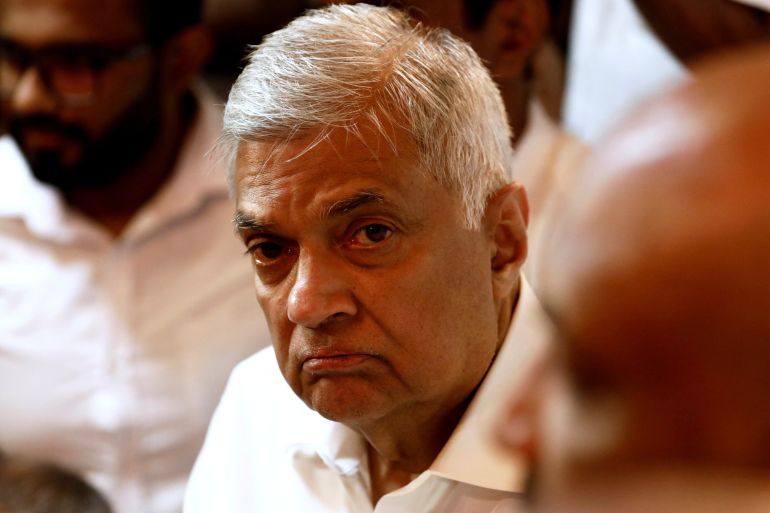Ranil Wickremesinghe elected crisis-hit Sri Lanka’s new president
Legislators tap the six-time PM as president, defying risk of more protests by people angry over a deepening economic crisis.

Colombo, Sri Lanka – The parliament in Sri Lanka has elected veteran politician and six-time Prime Minister Ranil Wickremesinghe as the crisis-hit island nation’s eighth president.
Wickremesinghe secured 134 votes while his main rival Dullas Alahapperuma received 82 votes in the presidential election by the 225-member parliament on Wednesday.
Keep reading
list of 4 items‘Supreme power of people’: Sri Lanka marks 100 days of protests
Sri Lanka’s acting president declares another state of emergency
PM Ranil Wickremesinghe sworn in as Sri Lanka’s interim president
The third candidate, Marxist leader Anura Kumara Dissanayake, managed three votes – all from his own party.
Wickremesinghe’s win is a remarkable turn of fortunes for a man considered as “politically dead” by some analysts.
“I thank parliament for this honour,” the 73-year-old said after the secretary-general of the parliament announced his victory.

Wickremesinghe was appointed prime minister after Mahinda Rajapaksa was forced to resign in May this year over the island nation’s worst economic crisis since independence in 1948.
He was made the acting president after predecessor Gotabaya Rajapaksa fled the country and resigned by email last week.
Gotabaya was forced to escape after tens of thousands of protesters hit the streets in capital Colombo and occupied his official residence among other important government buildings.
‘Not what we wanted’
It was mainly because of the support from the ruling Sri Lanka Podujana Peramuna party (SLPP) that Wickremesinghe became the next head of state.
He had unsuccessfully contested the presidential elections twice since 2000, the last time against Mahinda Rajapaksa, the patriarch of the Rajapaksa clan.
Protesters accuse Wickremesinghe of going out of his way to protect the Rajapaksas from any harm and making deals with the powerful but unpopular family to outmanoeuvre political rivals.
Amid the unprecedented economic crisis that began earlier this year, Gotabaya turned to Wickremesinghe, hoping the veteran politician would help revive the economy.
But the appointment further angered protesters, who wanted the country’s ruling elite – largely controlled by the Rajapaksas – to go.
We know very well that Ranil Wickremesinghe isn’t the same as Gotabaya Rajapaksa. He is a more cunning person.
On July 9, tens of thousands of protesters hit the streets, occupying several government buildings including the presidential secretariat and Temple Trees, the official residence of the prime minister.
Wickremesinghe’s private residence in Colombo was also set on fire by the protesters.
The protests forced Gotabaya to announce his resignation and escape, first to the Maldives and then to Singapore.
But Wickremesinghe refused to step down and was declared the acting president tasked with the formation of a new government.
Wickremesinghe has won the general election several times but never completed the term as prime minister. He is now the head of state, a position he aspired to for decades.
Protesters say they will continue their “aragalaya”, the Sinhala word for “struggle”, until Wickremesinghe is gone.
“We are currently discussing our strategy and regrouping. We will definitely continue our struggle and our occupation at GotaGoGama until Ranil Wickremesinghe resigns. This is definitely not what we wanted,” protest leader Melani Gunathilake told Al Jazeera.
“We know very well that Ranil Wickremesinghe isn’t the same as Gotabaya Rajapaksa. He is a more cunning person. And recently he has even been trying to suppress the protest by imposing a state of emergency and sending air force helicopters over GotaGoGama. But I don’t think people will be intimidated by these actions anymore.
“Sri Lanka deserves a leader who actually cares for its people, not somebody who thinks about his political future.”